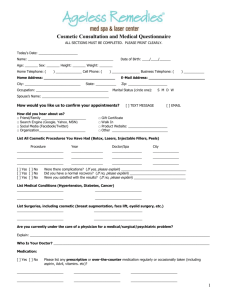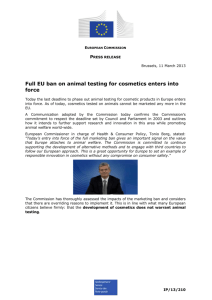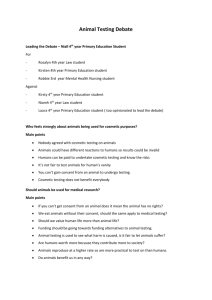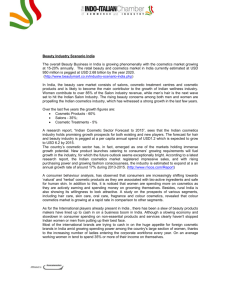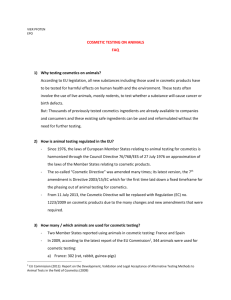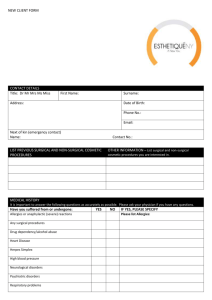Helping the people Aider les Canadiens et f C C
advertisement
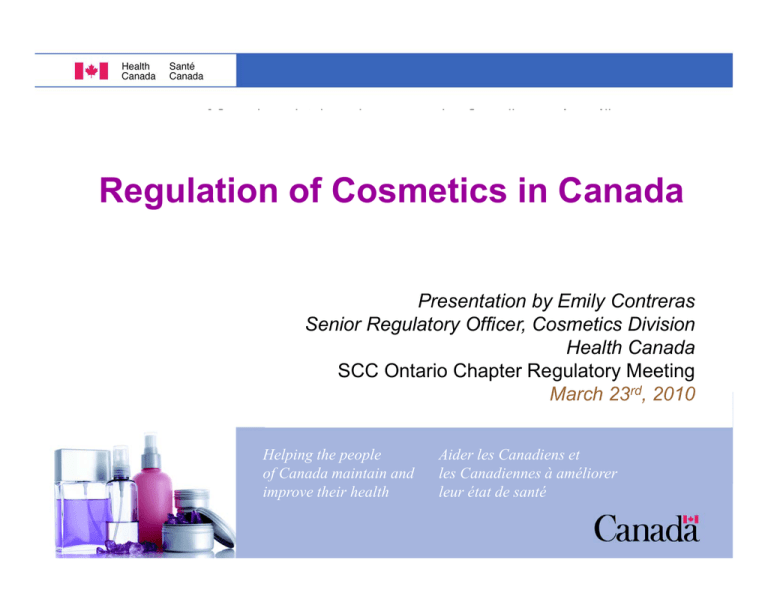
Helping the people off Canada C maintain and improve their health Aider les Canadiens et les Canadiennes C à améliorer leur état de santé Reg lation of Cosmetics in Canada Regulation Presentation by Emily Contreras Senior Regulatory g y Officer,, Cosmetics Division Health Canada SCC Ontario Chapter Regulatory Meeting March 23rd, 2010 Helping the people of Canada maintain and improve their health Aider les Canadiens et les Canadiennes à améliorer leur état de santé Presentation Outline • • • • • • • • • Health Canada’s Cosmetics Program Regulatory Authority Cosmetic (vs. drug) Classification & Claims Requirements of the Food and Drugs Act and the Cosmetic Regulations CEPA and the Chemicals Management Plan Tools for Industry Compliance & Enforcement Looking Ahead 2 Health Canada’s Cosmetic Program 3 Div vision B Bureau/ Division D Directorrate t partmen Bra anch Dep Minister of Health: Leona Aglukkaq Healthy Environments and Consumer Safety Branch (HECSB) Consumer Product Safety Cosmetics Regions and Programs (RAPB) (Inspectors) Safe Environments Chemicals Management Plan Health Products and dF Foods d (HPFB) Natural Health Products Therapeutic Products Medical Devices Other Branches / Agencies (Pesticides, P bli H Public Health, lth Food Inspection) Other Directorates: (Foods, Veterinary Drugs) Drugs Consumer Products New Substances Workplace Chemicals 4 Cosmetics Program • Cosmetics Division (HECS - Ottawa) Policies, regulations, scientific support, information kits, national coordination • Product Safety Inspectorate (RAPB - Six Regions across Canada) Enforcement, first line of contact for most complaints and enquiries Primary liaison with Customs (CBSA) (CBSA), Provincial Health Inspectors, US FDA, police (RCMP) 5 Cosmetics Program Mandate: To p protect and improve p the health of the Canadian public by minimizing health risks associated with the use of cosmetics marketed in Canada Canada. Met by: • Defining and communicating requirements for cosmetic manufacture, labelling, distribution, and sale • Monitoring compliance 6 Regulatory Authority 7 Authority • Program’s powers come from Food and Drugs Act (F&DA) and Cosmetic Regulations Cosmetics also governed by: • Consumer Packaging and Labelling Act (CPLA) and Regulations Net weight declaration and false and misleading claims • Canadian C di E Environmental i t lP Protection t ti A Actt (CEPA) New and existing cosmetic ingredients 8 Food and Drugs Act • Defines cosmetic, drug, food and device • Provides general safety requirement for cosmetics • Gives powers to the inspectors to search premises, take samples, seize products, stop sale, etc. • Contains: Contains Cosmetic Regulations Food and Drug g Regulations g Natural Health Product Regulations, etc. 9 What is a Cosmetic? “Cosmetic” “C ti ” iincludes l d any substance b t or mixture i t off substances manufactured, sold or represented for use in cleansing cleansing, improving or altering the complexion, skin, hair or teeth, and includes deodorants and perfumes. p • Scope in the above definition is not exhaustive because of the use of the term “includes” 10 Wh t is What i a Cosmetic? C ti ? Included*: 9Soap 9Deodorants / Antiperspirants 9Hair dyes 9Tattoo T tt inks i k 9Tooth whiteners 9Whitening chewing gum 9Breath B th strips ti 9Personal lubricants 9Nail adhesives Excluded*: ²Sunburn protectants (cosmetics can contain sunscreens if no labeling claims) ²Anti-caries toothpastes ²Antidandruff shampoo ²Injectables (collagen, botox) ²Intentionally swallowed products (vitamins, etc.) ²Devices and Articles (applicators, electrolysis machines, tanning beds, etc) 9Hotel H t l amenities iti 9Professional products * = Not an exhaustive list 11 What is a Drug? “Drug” includes any substance or mixture of substances manufactured, sold or represented for use in: a) the diagnosis, treatment, mitigation or prevention of a disease, disorder or abnormal physical state, or its symptoms, t i h in human b beings i or animals, i l b) restoring, correcting or modifying organic functions in g or animals,, or human beings c) disinfection in premises in which food is manufactured, prepared or kept. 12 What is a Natural Health Product (NHP)? • Defined in the Natural Health Products Regulations, not in the Act • A subset of “Drug”, it is a therapeutic product whose active ingredients come from a “natural” source. • Came into force January 1, 2004 13 Classification: Cosmetic vs Drug* • To determine if a product is a cosmetic or a drug, one must look at: the claims that appear on the product the ingredients present in the product • See Guidance on the Classification of Products at the Cosmetic Dr g Interface Cosmetic-Drug * “Drug” means Therapeutic Product or NHP 14 Why Are Claims Important? • A large component of product classification under the F&DA is how it is represented for use i.e. the claims associated with the product product. • Claims include what is on the label and all advertisement/promotion p associated with the p product • Changing a claim could cause a cosmetic to be classified as a drug or vice-versa, and therefore subject bj t to t different diff t regulations l ti under d th the F Food d and d Drugs Act. 15 Classification Product Purpose: Cosmetic or Drug ? Skin Cream Cosmetic: Moisturizes the skin Diaper Rash Cream Drug: Treats a skin disorder (rash) Lipbalm Cosmetic: Moisturizes the lips Lipbalm with SPF 15 Drug: Protects the skin on lips from sun damage 16 To represent your product as a cosmetic • Some claims can be modified so that they are qualified in a cosmetic sense (e.g. in terms of appearance/looks, via moisturization): “reduces “ d wrinkles” i kl ” Æ drug d claim l i vs. • “reduces the look of wrinkles”Æ cosmetic claim “heals heals skin skin”Æ Æ drug claim vs. vs • “moisturizing to heal dry skin”Æ cosmetic claim “kills g germs”Æ drug g claim vs. • “kills bacteria that cause odour”Æ cosmetic claim 17 More about Claims… • Cannot C t make k reference f to t Health H lth C Canada, d th the Act or Regulations on labels or in advertising, and cannot suggest cosmetic is a prescription • Cannot make false and misleading claims on label and advertisement under The Consumer Packaging and Labelling Act, and The Competition Act These also prohibit deceptive packaging 18 History of Regulations for Cosmetics: • Cosmetics first considered in 1939 • Regulations incorporated into the Food and Drug Regulations (FDR) in 1956 • Cosmetic Regulations split from FDR in 1977 • Amended from time to time based on changing circumstances Notification of cosmetics became mandatory in 1978 Mandatory ingredient labelling in 2006 • Undergoing review/modernization over the next few years as part of the Food and Consumer Safety Action Plan 19 Summary of Authorities & Requirements: Food and Drugs Act: Definition of cosmetic General Safety Requirements Powers P off Inspectors I t Cosmetic Regulations outline requirements for sale: Import Labelling Warnings/Cautions/Directions for safe use Specific products/ingredients Notification Page 20 20 S.16 of the Food and Drugs Act: The General Safety Requirement • Basis for prohibition or control of ingredients (in the Cosmetic Regs and the Cosmetic Ingredient Hotlist) • Also basis for need for quality control systems for impurities and micro-organisms, packaging and storing conditions • Although there are no specific requirements for Good g Practices ((GMP), ) HC encourages g use of ISO Manufacturing Cosmetics GMP Standard: 22716 21 Ingredient/Product Safety • In addition to general safety requirement in the Act, the Cosmetic Regulations outline controls for: Chloroform, estrogenic substances, mercury, PPD and coal tar hair dyes, methyl alcohol, potasium bromate and d sodium di b bromate, t genital it l d deodorants. d t P Prohibits hibit products that remove stains from teeth with <pH 4 • All other ingredient g controls are outlined in the Cosmetic Ingredient Hotlist 22 Labelling Requirements 9Appropriate cosmetic claims • Directions for safe use • Warnings • Requirements for cosmetics in pressurized containers • Special Packaging • Product identity and the responsible company • Ingredient Labelling • Bilingual requirements 23 Directions for safe use (s. 24 of Cosmetic Regs) • The label of a cosmetic that presents an avoidable hazard must include directions for safe use. • “Avoidable hazard” means a threat of injury to the health of the user of a cosmetic that can be (a) predicted from the cosmetic cosmetic’ss composition and the site of application; (b) anticipated during normal use; and ( ) eliminated (c) li i t d b by specified ifi d lilimitations it ti on th the usage off th the cosmetic. 24 Warnings • Some ingredients g or p products require q warnings g to alert consumers of a special hazard e.g. Cosmetics containing Alpha hydroxy acids (AHAs) require a warning to alert consumers about sun safety when using these products • See the Cosmetic Ingredient g Hotlist for ingredients g that may require warnings • If a warning is required, usually wording does not need tto be b word d ffor word d if th the tterm “t “to the th effect ff t of” f” precedes the warning on the Hotlist 25 Pressurized Containers • Aerosol products in a metal pressurized container Does not include p pump p sprays p y or those in p plastic containers • Must meet the requirements of the Consumer Chemical Container Regulations (CCCR) under the Hazardous Products Act as they read on Sept 30 30, 2001 2001. This means the old version of CCCR. 26 Pressurized Containers • These containers require a explosive symbol along with the appropriate signal word and hazard statement • Also may need a flammability symbol, depending on whether product is tested as fl flammable, bl the th llength th off th the flflame and d whether there is flashback • See S Labelling L b lli R Requirements i t ffor C Cosmetics ti iin Pressurized Containers 27 Special Packaging • Mouthwashes: require tamper-evident security packaging • Security packaging is not required for any other cosmetic at this time • Child Resistant Containers required for Methyl alcohol, potassium bromate and sodium bromate 28 Product Identity and Manufacturer • Consumer Packaging and Labelling Act and Regulations requires Declaration net quantity on inner and outer label Common name of the product on outer label Name and address of dealer on outer label • Cosmetic Regulations complement this by requiring on inner label Product identity and name and address of “manufacturer” (a.k.a. dealer) 29 Product Identity and Manufacturer • Product identity is not required if identity is obvious (e.g. soap or lipstick) • Manufacturer M f t address dd needs d tto be b d detailed t il d enough h so that a letter mailed can reach manufacturer In some cases this is just a postal code 1-800 or email address only is not sufficient Address does not need to be in Canada 30 Ingredient Labelling • List of ingredients must be in INCI nomenclature and on outer label Trivial names outlined in the Schedule of the Cosmetic Regs must either be in Latin, or in English and French. Eg. “Aqua/Water/Eau” or “Water(Eau)” If an ingredient has no INCI name, must use chemical name Must be prominent and legible 31 Ingredient Labelling • Descending D di order d off predominance, d i exceptt Ingredients at less than 1% Colouring agents • In case of colour cosmetics can use the term “May contain/Peut t i /P t contenir” t i ” or “±” “ ” • Incidental ingredients that do not end up in final formulation do not need to be listed as ingredients 32 Ingredient Labelling – Outer Label • Where product has an inner and outer label, ingredients don’t have to be on inner label • Where a product has only one label, all requirements must be on that label • Where product is too small/ornamental to carry a label, can put ingredients on tag, tape or card (affixed unless bulk) 33 Bilingual Requirements • Any labelling requirement of the Cosmetic Regulations (except INCI) must be in English and French sold anywhere in Canada • If you sell products in Quebec: under Bill 101, all must be in at least French (including any descriptions) • Exception is the ingredients when listed in INCI as per the C Cosmetic i R Regulations l i • Bill 101 = Quebec Charter of the French Language 34 Notification • Importer or manufacturer responsible for ensuring notification • Post-market: Post market: within 10 days of sale • Required for new products, formulation changes g and discontinued p products • Notification for each product: manufacturer(s)/distributor, purpose, physical form and formulation No fee 35 Notification • Product details entered in Cosmetic Notification System (CNS) Name, purpose, contact info, formulations A unique identifier (CNF#) is generated for easier reference • Formulations entered are verified against g the Cosmetic Ingredient Hotlist 36 Notification • Not a product evaluation or approval procedure • Acceptance of the completed form or labelling by Health Canada does not constitute constitute, in any way, agreement that the product is in compliance p with all regulatory g y requirements q 37 Do I wait for a response? • No. We do not send an acknowledgement since we receive over 20,000 notifications every year. • You Y mustt specifically ifi ll requestt one if you wantt one • Acknowledgement letter is not necessary to continue sale in Canada (assuming you’ve you ve met all of the regulatory requirements) 38 If you don’t hear from us, that’s usually a good thing We may contact you for: • Missing information/Clarification • Not N t a cosmetic ti • Hotlist ingredient • Unacceptable claims • Safety Data • Complaint 39 Common Notification Errors • Illegible writing (small font, poor handwriting) • Concentrations missing g • Unknown ingredients (use INCI or another standard reference where possible) p ) • Not signed • Unsure whether this relates to multiple products or one 40 Canadian Environmental Protection Act (CEPA) and the Chemicals Management Plan 41 CEPA: The Canadian Environmental Protection Act • In Canada, all ingredients, including those in cosmetics, are subject to Canadian E i Environmental lP Protection i A Act (CEPA) • Two Streams under CEPA treated differently: New Substances Existing Substances Delineation D li ti b based d on whether h th th the substance b t iis on th the national chemical inventory (Domestic Substances List) 42 A “New Substance” means.. • Not on chemical inventory (Domestic Substances List)) Subject to the New Substances Notification Regulations •Trigger is 100 kg annual import or manufacture •Exception for substances on In Commerce List (ICL): will be reviewed under future environmental assessment regulations 43 “Existing Substance” • On Domestic Substances List Substances screened, categorized and prioritized for assessment under the Chemicals Management Plan (CMP) High priority substances are subject to an information request and assessment under The CMP Challenge (see next slide) • Cosmetics Division works with the CEPA programs to share information and to communicate risk management approaches Can use the Hotlist to risk manage ingredients assessed under CEPA if concern to human health 44 The Chemicals Management Plan (CMP) • 200 high priority substances on the DSL are part of The CMP Challenge • 12 Batches of 15-25 substances launched in Canada Gazette, Part I every 3 months, months Feb 2007-Dec 2007 Dec 2009 • Each batch has questionnaire for importers, manufacturers and end users. • Each E h substance b t undergoes d a screening i llevell assessmentt b by Health Canada and Environment Canada Recommend risk management approaches if designated as “Toxic” to humans or the environment See Hotlist slides 45 CMP – Medium Priorities • • • • • 631 Medium health priorities for CMP 2000 Medium eco priorities Search of CNS revealed 42% in CNS Developing criteria for prioritization Will engage g g industry y regarding g g issues of p prioritization, data gathering and assessment 46 Industry Tools • Hotlist • Guidance Documents and the HC Website 47 The Cosmetic Ingredient Hotlist • List of prohibited and restricted ingredients in cosmetics in Canada • Created C d iin 1995 b based d on policies li i regarding di certain ingredients used in cosmetics • Cosmetic Regulations contained some prohibited or restricted ingredients, but did not capture p other ingredients g that should not be used in cosmetics 48 The Cosmetic Ingredient Hotlist • Currently 700+ substances on list. Not exhaustive. • Originally O i i ll b based d on EU’s EU’ Cosmetics C i Di Directive’s i ’ Annex II & III • Composed of ingredients: known to cause adverse health effects, or which are limited to pharmaceutical applications 49 The Cosmetic Ingredient Hotlist • Not entrenched in the regulations Changes do not undergo extensive regulatory amendment process Updated once or twice per year • List is considered to be an elaboration of s. 16 of the Food and Drugs Act which states that No person shall sell any cosmetic that has in or on it any substance that may cause injury to the health of the user 50 How are ingredients nominated for review? Come to Program Program’s s attention through: New scientific information New regulatory decisions (domestic or international) Consumer complaints Media Industry request Other concerns 51 How are ingredients nominated for review? Prioritized for assessment based on: Available evidence Injury complaint Synchronization with other decisions in GoC (e.g. (e g proposed changes to Food and Drug Regulations by HPFB) Perceived risk etc. 52 Sources of Information • Opinions of EU’s Scientific Committee on Consumer Products (SCCP) • Cosmetic Ingredient Review (CIR) • Assessments/reviews conducted byy other groups within Government of Canada • Scientific literature 53 Review Process • Substance undergoes Screening Review Compilation of scientific and regulatory information into a Cosmetic Ingredient Profile This usually provides sufficient evidence to make a decision 54 Review Process • If there are still questions/concerns, the substance will undergo a more in-depth Risk A Assessment (C (Cosmetic i P Policy li D Decision i i Document) Considers C id M Margin i off S Safety f t and d Ri Risk/Benefit k/B fit • Power to ask companies for information under the Cosmetic Regulations 55 Outcome of Assessment • Add to Hotlist: Prohibit • Add to Hotlist: Restrict through Concentration Method of application (e.g. aerosol vs liquid) Type of product used (e.g. rinse off vs leave-on product) Addition of cautionary statement Child-resistant packaging • Insufficient information • No objection to current use in cosmetics 56 Next Steps for Hotlist Update • Affected companies informed • Draft Hotlist p published to Web • 60-day comment period • Any submitted supporting data reviewed • Final Hotlist published to Web 57 Hotlist Update • Last update p September p 2009 http//www.healthcanada.gc.ca/hotlist • CMP Batch 1&2 of Hotlist: Draft underwent consultation until Dec 23 • Hydroquinone: Further restrictions – same as EU • Methyloxirane monomer - prohibition • Naphthalene - prohibition • Toluene Diisocyanates - prohibition • CEPA-related CEPA related housekeeping issues (SNAc substances), and minor cosmetic amendments 58 Hotlist: Coming Soon • Comments reviewed • Removing references to CEPA actions (SNAc) Possibly listed in a separate document • Next edition will reflect CMP Batches 3-5 (all prohibitions): Batch 3 - DEGME, Methoxyethanol acetate, PGME, PGMEA 2-Methoxypropanol, PGMEA, 2 Methoxypropanol 2 2-MEA, MEA Pigment Red 3 Batch 4 - 1,3-Butadiene, DES, DMS Batch 5 - Acrylamide (monomer) 59 The HC Website: Guidelines to Help You http://www.healthcanada.gc.ca/cosmetics • Guidelines for Cosmetics Manufacturers, Importers and • • • • • • • • Distributors The Guide for Completing Cosmetic Notification Forms Guidelines for the Labelling of Cosmetics Guide to Cosmetic Ingredient Labelling Labelling Requirements for Cosmetics in Pressurized Containers Guidelines for Cosmetic Advertising and Labelling Claims Guidance on the Classification of Products at the Cosmetic-Drug g Interface Cosmetic Ingredient Hotlist Act and Regulations, etc. 60 Compliance C li and d Enforcement: E f t Working with an inspector 61 Compliance and Enforcement: Working with an inspector • Product Safety inspectors enforce the Cosmetic Regulations • Powers P are iin th the Food F d and dD Drugs A Actt and d Cosmetic C ti Regulations Can inspect p p premises where cosmetics sold,, manufactured or stored, take samples for testing or take photographs Can recommend refusal of imports or allow a non-compliant product to be imported to be brought into compliance under their supervision Can seize a cosmetic 62 Circumstances under which an inspector might contact you • Non-compliance in regard to cosmetic that: is being imported (referral from Canadian Border Services) was found on the market, as a result of • an inspection on the market • sampling performed during a routine market survey • a trade/consumer complaint • notification screening is being advertised to Canadians (internet, broadcast, etc) was found during an inspection of the manufacturing plant • Investigation of an injury complaint 63 Working with an inspector • Under the law, law anyone on premises must assist the inspector if necessary. Cannot falsify information,, hinder or obstruct the inspector p as they are doing their duty. Cannot remove or alter anything seized by the inspector. • Follows the HECSB Compliance and Enforcement Policy 64 Actions taken will depend on: the risk to health and safety, the likelihood that the same problem will reoccur, the compliance history of the enterprise, whether the enterprise acted with indifference or premeditation, the degree of cooperation offered by the enterprise, Branch and Programme priorities and available resources, the chances of success of the enforcement action being contemplated, and the need to maintain public confidence. 65 Working with an inspector • Don Don’tt panic! Provide assistance where possible. possible • Voluntary approach always taken before inspectors use their powers under the Act. • If product can be brought into compliance, inspector may ask for a written commitment from you. In I other th cases, product d t may be b refused f d from f import i t or further f th sale, or may need to be recalled • Inspectors p will not do all the work for yyou. Hire a consultant if you do not know how to comply. 66 Looking Ahead • International Cooperation (ICCR) • Nanomaterials and Cosmetics • GMPs • Modernization of the Cosmetic Regulations • Classification of Products at the CosmeticDrug Interface • CosMos – online notification system 67 International Cooperation on Cosmetic Regulation • Canada part of regulatory dialogue with regulatory representatives of US, EU and Japan as well as industry counterparts Japan, • Meet once a year face to face and have quarterly teleconferences • Issues include: alternatives to animal testing, sunscreens,, GMP,, ingredient g safety, y, labelling/packaging and nanotechnology • Next meeting July in Toronto 68 Cosmetics & Nanomaterials • Current regulatory framework has capacity to effectively deal with potentially harmful substances in cosmetics • However, the standard nomenclature used for cosmetics ((INCI)) does not identifyy nanomaterials (same with CAS, IUPAC, etc) • Therefore currently unable to identify which products d contain i nanomaterials i l 69 Cosmetics & Nanomaterials • Updated EU Cosmetics Regulation addresses nanomaterials via labelling, notification and safety substantiation • At this time, the information for nano in cosmetics is not compelling enough for HC to take this level of action 70 Current Activities: Nanomaterials • Focus is on international committee work: • • Member of the International Cooperation on Cosmetic Regulation (ICCR) with the US, EU and Japan International meeting in July 2009 on Nano in cosmetics that shared the current state of play and issues in regards to regulation of nano in cosmetics • Dec 2009 formation of the ICCR Nano Working Group – First step: Develop nano criteria relevant to cosmetics to g be used byy regulators – Second: Establish a set of safety principles that will guide the collective assessment of nanomaterials in cosmetic products 71 Next Steps: Nanomaterials • ICCR Nano WG outcomes will be used to develop a Industry Guideline for nano in cosmetics under the HC Interim Working Definition framework – Interim working g definition p published for consultation March 2010 – http://www.hc-sc.gc.ca/sr-sr/consult/_2010/nanomater/index-eng.php • Possible regulatory approach will focus on identification of nano in the Cosmetic Notification Form 72 GMPs • Canada C d h has committed i d through h h ICCR to adoption d i off ISO 22716: Cosmetics – Good Manufacturing Practices • GMP nott mandatory, d t however h strongly t l suggested t d given i llegall requirements for manufacture and storage under sanitary conditions • GMP page on HC Cosmetics website in early 2010 • No immediate intent to change level of compliance and enforcement activity for cosmetics GMP, though possibility of mandatory GMP may be explored in the future 73 Cosmetics Modernization - Why Now? • Key deliverable under the Government of Canada’s Food and Consumer Safety Action Plan • Some jurisdictions, in particular the EU, have been enhancing the way they regulate cosmetics. • Some provisions in the Cosmetic Regulations were simply cut and pasted from the Food & Drug Regulations; uncertain of their relevance to cosmetics • A full analysis and review required 74 Cosmetic Modernization Work Split into three main categories: 1. Legislative Modernization: F d and Food dD Drugs A Actt 2. Regulatory Modernization: Cosmetic Regulations g 3. Administrative Modernization: Policy and Guidance to deal with Interface Challenges 75 Approach to Regulatory Modernization • Policy analysis and a comparison of domestic and international regulatory frameworks to determine best practices in the following areas: compliance/enforcement notification/assessment packaging and labelling ingredients miscellaneous 76 Products at the Cosmetic-Drug Interface • Guidance on the Classification of Products at the Cosmetic-Drug Interface issued in 2008 • Provides clear criteria for determining what is a cosmetic versus drug: Representation Composition Level of Action Other: •Inherent risk-benefit balance •Precedents and past decisions •Classification schemes of other regulatory authorities 77 Products at the Cosmetic-Drug Interface • To date 3 product categories have been assessed against this criteria: diaper rash creams, medicated skin care and antiperspirants • Only antiperspirants reclassified to cosmetics • Companies affected by transition will be given until end of 2011 to change their labels • New antiperspirants must comply with cosmetic requirements immediately 78 Online Notification: COSMos • Currently: All notification forms entered into system by hand • Developing an online tool for better management and easier notification for companies p • IT development part of project still going slower than expected p 79 CosmOS – Cosmetics Online System • New Cosmetic Notification Form Version 1 was tested by industry volunteers; went very well • Still refining g form and user requirements q • Targeted CosMOS project completion April 2011(?) • Interested in contributing g yyour thoughts g on the notification form? Contact Christopher Pollard at christopher.pollard@hc-sc.gc.ca 80 Questions? For More Information: Cosmetics Program Website: • www.healthcanada.ca/cosmetics Contact Us: • cosmetics@hc-sc.gc.ca 81
